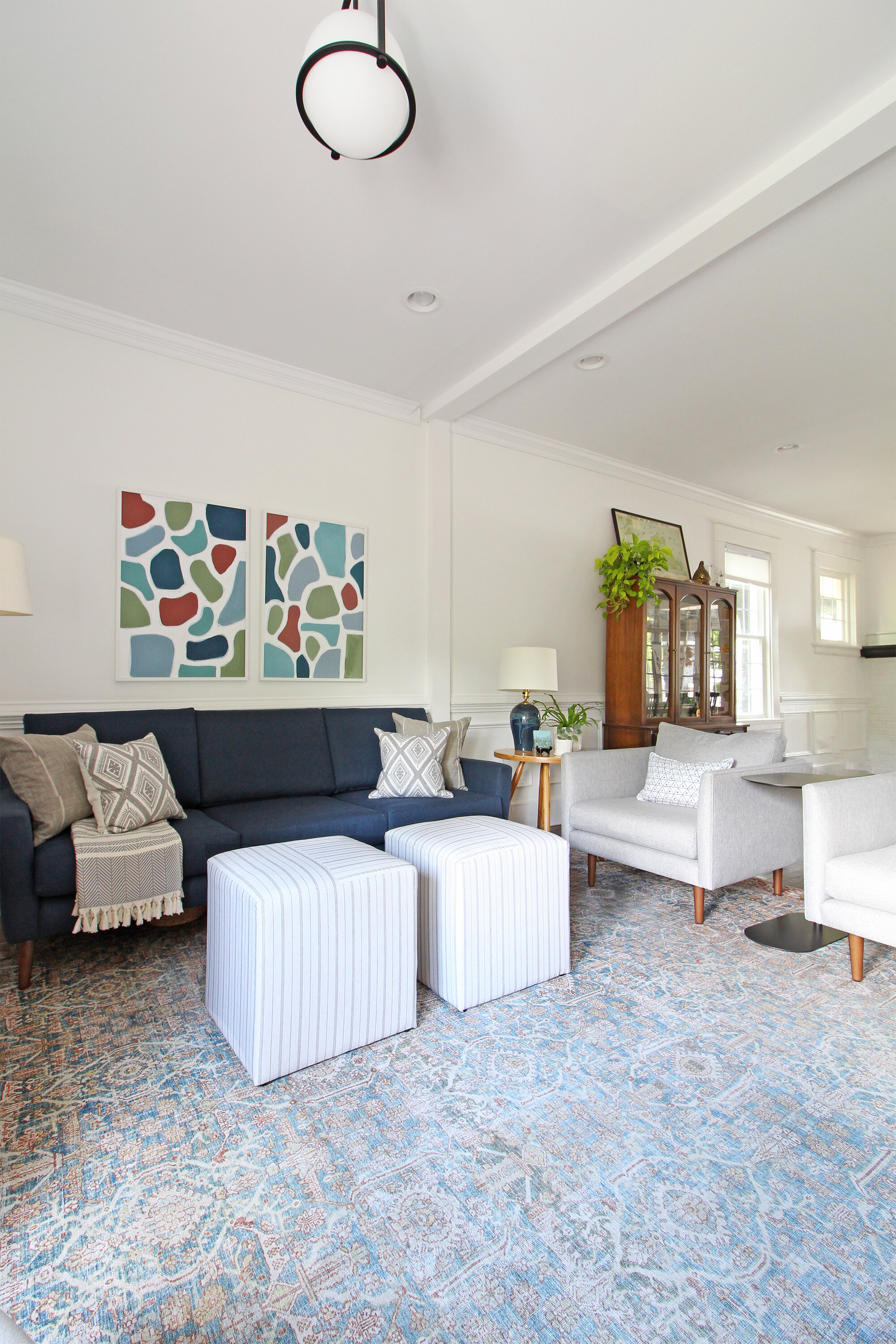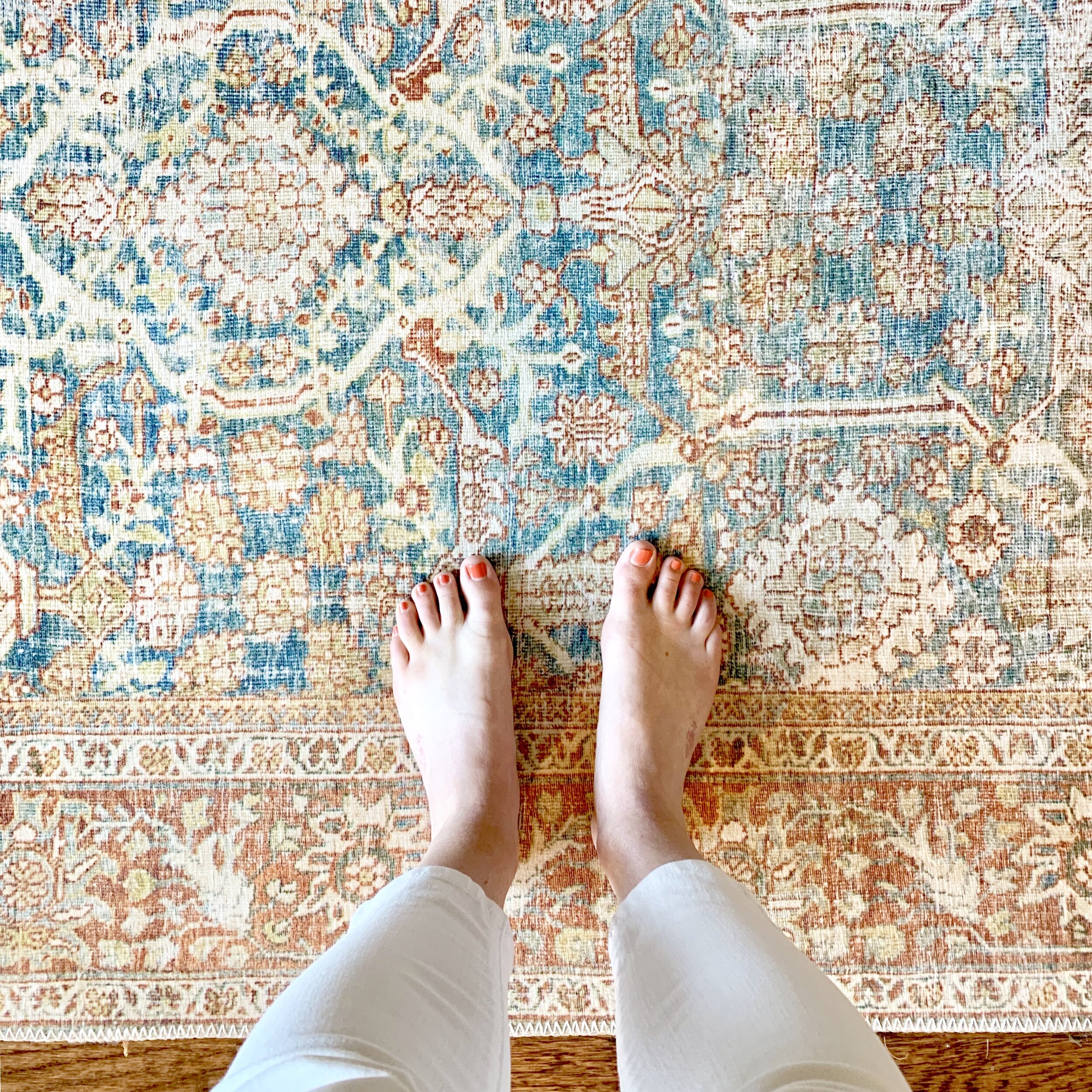8 Kid-Friendly Design Tips For Your Living Room
Kid-friendly design has become a high priority since we had our son last year. It doesn’t mean we have to sacrifice having a beautiful home though - it’s all about being thoughtful about what you bring into it and how you design it. I truly believe that!
When you’re designing spaces in your home with kids around - particularly the common spaces like living rooms and family rooms - it’s important to be flexible and allow them to evolve over time to meet your needs as your kids grow and change. That might mean exchanging a coffee table with sharp corners for an ottoman (at least for a little while!) or putting breakables up on a higher shelf while your kids are toddlers so you don’t have to stress about keeping curious little hands away.
The more you can work to create an environment that’s safe and worry-free, the more you and your kids can enjoy living in your home. “Nothing precious” has become my motto, but even with that in mind, I know I can still have lovely things!
I’ve designed a lot of rooms for my clients with children over the years (and now myself!) and I want to share eight design tips with you so you can create a home that works for you AND your kids.
The photos you’ll see throughout this post are from my own family room. It’s our main play space, but it doesn’t necessarily look like it, does it? Now granted, I did tidy up and there are usually some other bigger toys around, but I wanted to show you the space itself to offer some inspiration for how you could design a living room that’s made for actual living while making it enjoyable for adults too.
So grab your cup of coffee and let’s dive in - I’ve got a lot to talk about today!
1. Opt for performance fabrics on sofas, chairs, and ottomans when possible.
In case you’re unfamiliar with the term “performance fabric” - it’s pretty much what it sounds like. These fabrics are designed to be highly durable and stand up to lots of wear and tear. I often recommend them for upholstery pieces, especially sofas and chairs. They can be a little more expensive, but investing in them now means that your furniture will last longer and you won’t need to worry about grubby hands or spilled drinks. There are different kinds of performance fabrics: some repel stains all together, some are machine washable, and others are easily spot cleaned with a little soap and water or a cleaning solution.
So how do you know you’re getting a performance fabric? Well, since they’re becoming more popular and more widely available than in the past, you’ll often see them labeled either as “performance fabrics” (easy to spot!) or by their brand names. Good ones to look out for are Crypton, Sunbrella, Revolution Fabrics, Inside Out Fabrics, or Perennials.
We have performance fabric on both of the sofas in our home. The fabric on the navy blue one* seen here is made of Olefin (a fabric you’ll see a lot in the performance fabric world) and the white slipcovered one in our front room is upholstered in Crypton.
2. Busy rugs are your friend
The blessing and the curse of rugs with a lot of pattern is that they hide everything. I generally see this as a good thing when you’re designing a room with kids in mind. After living with one that falls into that category now for about a year, I can say with confidence that I love not being able to spy every little crumb or worry about a spit up stain (sorry if that’s TMI, but it’s #reallife!). Regular vacuuming and a little carpet cleaning every once in awhile will keep it looking fresh and clean.
If you’re a fan of the vintage/updated traditional rug trend, it’ll be easy to integrate a busy pattern into your living space. There are lots of options in other styles, but that look in particular works beautifully. We have this one that has the look of a vintage Persian rug and we’ve loved it. It has almost zero pile, but it’s super soft underfoot. (I’ll note that it definitely needs a nice, thick rug pad since it’s on the thin side.)
3. Choose durable materials for pieces that see daily use
Kids can (unfortunately) wreak havoc on furniture and decor, so being thoughtful about what things are made out of and how they function is important. It’s hard to be super specific on exactly what those materials should be since you can find high and low quality pieces made from the same stuff.
In general though, choosing a material like solid wood over laminate, or a storage piece with good hinges that open and close easily are smart ideas. Consider how things are constructed and what they’re made of so that you can be confident they’ll last. When you’re shopping online for pieces, read the description details and reviews carefully. I can’t stress that enough. Be a detective - those pieces of information should give you a good indication of its quality.
4. Include a mix of open storage and closed storage options
This one falls under both the organization and design umbrellas. I love to have a combination of open and closed storage pieces in a home to give lots of optionality. With this setup, you can display some pretty pieces that make you smile and have things like toys and games accessible for your kids while keeping the visual clutter to a minimum behind some closed doors.
This might mean having a cabinet with doors paired with an open bookshelf, a large storage ottoman alongside a side table that has a couple of open shelves, or if you’re tight on space, a single bookcase that has both open and closed storage like this one.
In our home, we have a vintage mid-century cabinet that holds a ton of toys in our family room, and then an open bookshelf in our front living room. Having one area to style and another to hide things like tiny toy cars, books, and art supplies works really well for us.
5. Make your space flexible and have the ability to move things around as needed
As it stands right now, can you clear enough floor space for an impromptu dance party? That might sound like a silly question, but it tells you a lot about how flexible your living room is. Whether you have a baby who is learning to crawl or bigger kids who want to build forts, having the ability to easily transform a space into one that’s ready for all of your kids’ creative playtime ideas is a wonderful way to give them some ownership of their home and feel comfortable in it.
A few months ago we exchanged a larger coffee table for a set of two smaller ottomans and have really enjoyed being able to create a large play space for our son to spread out and play with toys both large and small. Because the ottomans are lightweight, I don’t think twice about moving them around throughout the day. Then in the evenings, I just “reset” the room so it’s ready for adult hangout time. It’s been working really well for us!
6. Swap a coffee table for an ottoman or choose a table with rounded edges
Speaking of ottomans, this is something I’ll often suggest for families with small kids. If you’re worried about your newly minted walker running into sharp corners, something soft may be the way to go. Or, if you’re more of a coffee table person, choosing a round one rather than a square or rectangle may do the trick.
This can also be a good idea if your kiddos tend to get a little rough or reckless during playtime. I’m all for active play, so I’d rather create an environment that’s conducive to that rather than always needing to yell, “Be careful!” Of course, as parents, we’ll always be saying that to our kids, but by making smart furniture choices we may not have to say it quite as often!
Need some coffee table or ottoman ideas? Check out this post!
7. Move your most-loved or highly breakable decor and accessories to safe spots
Inevitably, things will get broken. This is another spot where my motto, “nothing precious,” comes into play. If it would make you incredibly sad to see a favorite piece break or get messed up, move it to a different place that’s out of a child’s line of fire. Things like ceramic table lamps, anything made of glass, vases, plants, etc are what come to mind for me.
Of course, you can keep some breakables around too (if it’s safe to do so) and use the opportunity to teach your children about taking care of their home and the pieces in it. For example, we have a ceramic table lamp on a side table in our family room that I plan on keeping there. When our son goes near it, we talk about how he needs to be careful with it because it’s breakable. While he’s still young and can’t totally understand the concept, it can’t hurt to start now! On the other hand, I had a set of heavy vases on a coffee table that I felt like I needed to move since he could easily knock them over given their accessibility.
8. Look for stable pieces and anchor items to the wall when possible
My final piece of advice is a functional and safety-focused one - choose pieces with good stability and when you can, anchor pieces with a fall risk to the wall. I’m guilty of not doing the best job of the latter, but as I’ve watched our son explore our home and grab at just about everything, I’m realizing that I’ve got work to do.
In terms of stability, here are three examples of items that tend to work well:
Tripod floor lamps rather than single stem - a tripod style distributes weight to more than one point on the floor
An accent piece (like a side table) with a base that’s as wide as the top or is weighted so it won’t topple easily
Shelves or cabinets with built-in anchoring areas or that have to be installed on the wall to function properly
Whew! That was a lot, but I hope these tips are helpful and will inspire you to create a home that’s both beautiful and functional for your children. Have more ideas? Be sure to share them in the comments!
*This post contains affiliate links, which means Mix & Match Design Company earns a small commission from your purchase at no cost to you.







